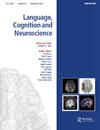形态学处理受损:来自多发性硬化症的见解
IF 1.8
3区 医学
Q2 AUDIOLOGY & SPEECH-LANGUAGE PATHOLOGY
引用次数: 0
摘要
本文章由计算机程序翻译,如有差异,请以英文原文为准。
Impaired morphological processing: insights from multiple sclerosis
ABSTRACT
Multiple Sclerosis (MS) is a neurological disease characterised by damage affecting large bundles of white matter fibres. Morphological segmentation of complex words (e.g. walked) into stems (walk) and suffixes (∼ed) is thought to depend on intact white matter. We tested the hypothesis that Arabic speaking patients with MS may lose the ability to segment morphologically complex words in a primed lexical decision task using word pairs that shared either a root and a semantic relationship (+R + S, e.g. “AnzAl”–“nuzwl” lowering-landing), a root without semantics (+R–S, e.g. “rtAbp”–“trtyb” monotony-tidying up),a semantic relationship (–R + S, e.g. “xyr”–“nEmp” good-grace), or a phonological relationship (–R + Phon, e.g. “mEdn”–“mEAnd” mineral-stubborn). While healthy controls showed priming by root regardless of semantics and inhibition by phonology, the patients showed facilitation by semantics (+R + S and –R + S), and inhibition by phonology (–R + Phon). These findings are used to adjudicate three contending models of lexical processing.
求助全文
通过发布文献求助,成功后即可免费获取论文全文。
去求助
来源期刊

Language Cognition and Neuroscience
AUDIOLOGY & SPEECH-LANGUAGE PATHOLOGY-BEHAVIORAL SCIENCES
CiteScore
4.50
自引率
13.00%
发文量
70
期刊介绍:
Language, Cognition and Neuroscience (formerly titled Language and Cognitive Processes) publishes high-quality papers taking an interdisciplinary approach to the study of brain and language, and promotes studies that integrate cognitive theoretical accounts of language and its neural bases. We publish both high quality, theoretically-motivated cognitive behavioural studies of language function, and papers which integrate cognitive theoretical accounts of language with its neurobiological foundations.
The study of language function from a cognitive neuroscience perspective has attracted intensive research interest over the last 20 years, and the development of neuroscience methodologies has significantly broadened the empirical scope of all language research. Both hemodynamic imaging and electrophysiological approaches provide new perspectives on the representation and processing of language, and place important constraints on the development of theoretical accounts of language function and its neurobiological context.
 求助内容:
求助内容: 应助结果提醒方式:
应助结果提醒方式:


